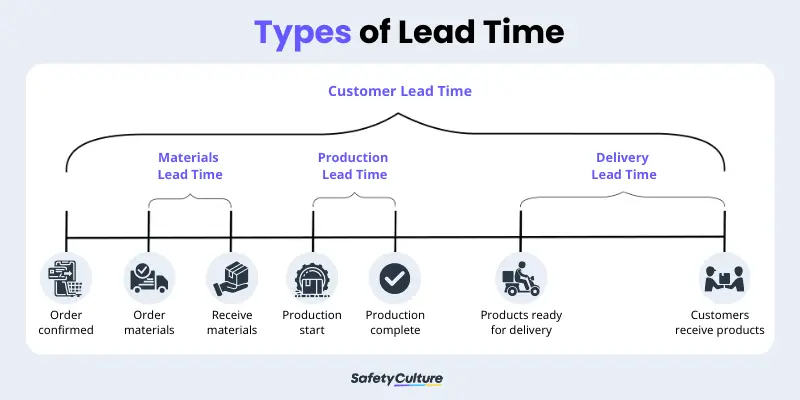What is Lead Time?
Lead time refers to the time or duration it takes for a production process or project to be completed. Hence, lead time in the supply chain means the amount of time from the point that an entity (vendor, producer/manufacturer, warehouse, distributor, supplier, and retailer) processes an order, manufactures a product, or prepares an order to the point it gets delivered to the customer.
The term lead time is used in a variety of industries and fields, including manufacturing, supplier management, project management, and supply chain management.
What is the Difference Between Lead and Delivery Time?
While lead time pertains to the overall duration or interval of processing the order until the customer receives it, delivery time is the time it takes for the product or service to be transported to the customer.
Why is Lead Time Important and How to Calculate it?
Lead times serve as a key business metric. Aside from being used to ensure companies consistently meet customer expectations, lead times also help forecast inventory, anticipate sales, plan for customer demand, and streamline operations. In relation to that, reduced lead times can translate into improved fulfillment rates of orders, efficient use of warehouse space and resources, and smoother workflows.
In every entity in the supply chain, lead times vary depending on the specific activities involved and the gravity of work being performed by the team members and stakeholders. With this in mind, it’s crucial to remember that there may be dependencies in your overall supply chain process.
To help you manage such cases and better plan your operations, knowing the various formulas for each entity’s lead time and how to calculate them is helpful. According to Investopedia, the following may apply:
- Overall lead time = Pre-processing time + Processing time + Post-processing time
- Lead time in manufacturing = Procurement time for raw materials + manufacturing time + shipping time
- Lead time in retail = Procurement time for finished products + shipping time
Types

Types of Lead Time in the Supply Chain
As previously mentioned, lead times vary per entity in the supply chain. The 5 common types are the following:
- Customer Lead Time – the time from when the customer’s order is confirmed until it’s fulfilled
- Material Lead Time – the time that it takes to procure materials from suppliers and have them ready for use during the production process
- Production Lead Time – the duration of the overall production process
- Cumulative Lead Time – the sum of the material lead time and production lead time
- Delivery Lead Time – the time it takes for the order or shipment to get to the customers
Factors
It’s important to understand the elements or processes that contribute to the efficiency of supply chain operations to optimize and reduce the time it takes to finish products. Hence, what factors affect lead time? Here are some of them in detail.
Inventory management system
The efficiency of your organization’s inventory control affects the way you ensure reduced lead times and enhanced customer satisfaction. Depending on your business needs, there are a lot of inventory management systems you can consider implementing.
One example is Just-in-Time (JIT). One of the benefits of shortened lead times associated with a JIT system is that it focuses on manufacturing and delivering only what is needed, when it is needed, and how much is needed just in the time it was actually demanded.
Production processes
The processes being used by an organization to produce goods and move them in the supply chain must be efficient to prevent delays, stick to the predicted schedule, and avoid potential customer returns.
Suppliers
Suppliers working with organizations must be best-fit for the business to meet demands throughout its operations. To ensure this, supplier quality management (SQM) must be established and continuously improved.
Tips to Control and Shorten Lead Time
While there are a number of things affecting supply chain lead times that companies can’t anticipate (i.e., human error, natural disasters, and raw material shortages), a huge deal of factors can be mitigated, managed, and improved. This brings confidence to key stakeholders knowing they can look for continuous improvement opportunities and further optimize their operations. That said, here are some tips on how to improve and control your lead times:
Reassess your processes.
Make time to analyze your existing systems and activities to assess whether valuable outputs are being created or maximized. Remove those that are unnecessary, improve those that bring little value, and ideate new ones that can benefit your business.
Establish strategic inventory management.
In terms of inventory, you can reorder more frequently in smaller batches rather than in bulk, which may take time to produce and arrive at your warehouse. This way, you avoid the risk of stockouts which can then cause delays in your lead time.
However, high inventory levels can also bring disadvantages to your organization. These include higher storage costs, additional labor in warehouses, and limited cash flow. This is why it’s important to consider the best way to manage your inventory that benefits the organization without compromising customer satisfaction.
Create Your Own Inventory Checklist
Eliminate manual tasks and streamline your operations.
Get started for FREEEnsure everyone is well-informed on your operations.
Improving internal communications is one way to let everyone involved in your supply chain operations be on board with best practices. Using tools and platforms in this aspect of your business is also a must to bridge workplace communication gaps.
Maximize the power of automation.
Any level of or approach to streamlining an organization’s workflow processes can have a small or big impact on its overall operations. Hence, automating tasks and activities that are redundant or can be done using tools and platforms is advisable. One example is an operations platform or workflow software that you can set up and integrate with your existing system.



